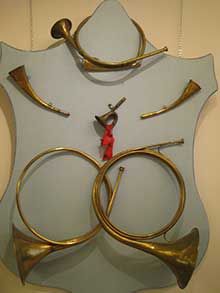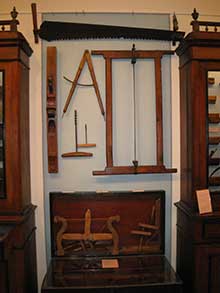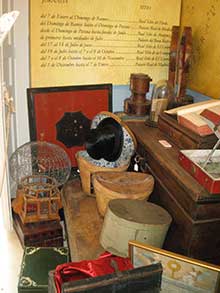This exhibition takes place in the remaining part of the original site of Cocheras (the Old Royal Coach House) and aims to show the history, activities and development of the old buildings at the service of the Royal Family for the century, since they were built in 1771 until the second half of the XIX century, when after the Peninsular War some of those buildings were very much rundown and, at the same time, became useless as the new transport and communication network developed. The exhibition includes the courtyard, porch, gallery, then up the main staircase to the first floor of the most important original building that still exists, having been restored to its former glory.This unique setting, exhibits, drawings and explanations take us back, enthralled, to the old times when the only way to transport people, merchandise and messages was using animals. At this came to an end when the first steam engine arrived at El Escorial (1861), the postage stamp came into use (1850) and the beginning of the telegraph, telephone and the automotive era.
The exhibition area is divided in VIII Sections:
I. NewsNoticias
II. Journeys and routesCaminos y Recorridos
III. Coming to a HaltParada y Estacionamiento
IV. Vehicles and equipmentVehículos y Dotaciones
V. Skilled workers needed for a journeyOficios del Viaje
VI. Packing and unpackingEmbalaje y Desembalaje de equipajes
VII. Processions and walksComitivas y Paseos
VIII. Woodlands and huntingBosques y Caza
I.NEWS
Passengers could get all information needed for the journey, price of transport, luggage and merchandise, layout of the land, distance between places, etc. through books, laws and by-laws, the press, post and later through the telegraph. Maps and plans were very useful but not very reliable as the trigonometrical studies were not applied.
Up to the XVIII, at home and abroad, there were many different units to measure weight, volume and longitude according to the district or town, with caused many problems in commercial transactions. Here we have on show several instruments to measure longitude (compasses, rulers, tape measures, Spanish yardstick, etc.) weight (dishes scales or trutine, Roman scales or statera, platform scales, etc.); volume (wooden boxes, measuring metal containers).
The cons were: gold coins or doubloons; divided into escudos; silver coins or reals, divided into pesos duro, pesetas and reals; and cooper coins. Royal bonds and bank notes came into use for the first time in Spain during the XVIII century.
II. JOURNEY AND ROUTES
Travelling by horse-drawn carriage was so gruelling that postillions and horses had to be changed every six to nine miles. Soon the organized regular services with a relay system for transporting passengers and mail, which was the beginning of the public transport and postal service. So the stagecoach was born. Between Madrid and El Escorial there were Relay Houses some of which could also be used as a Post Office. The importance of these Relay Houses in the development of the Spanish Postal system can be seen in the fact that Madrid’s main square Puerta del Sol or the Old Post Office are the Zero Mark of both roads and postal Spanish system.
The routes to get to El Escorial have changed since Monastery was built. Felipe II used to travel through Torrelodones and Toledo but during the reign of Carlos III the roads through Guadarrama or Galapagar became more popular.
III. COMING TO A HALT
Carlos II, the last Spanish king of Austrian descendant, commissioned his architect, del Olmo, the building of Caballerizas (the Royal Stables). Carlos III asked Juan Esteban to build Cocheras (the Royal Coach House) on the site we are standing now, surrounded by the streets calle del Rey, calle Patriarca, calle Loteria, Calle Clavario and calle Camino a Guadarrama. After the Peninsular War the Caballerizas were badly rundown and what could be saved was transferred to the grounds of Cocheras, both being together since the middle of the XIX century. After the acts of Freedom from Mortmain part of it was sold to private hands to build private homes. The rest remained as Royal Patrimony and 1931 was handed over to San Lorenzo de El Escorial County Council which used it as a State School. In 1974 it was demolished by the Country Council and rebuilt as the new school we see today.
Luckily the part of Cocheras that remained in private hands survived till the present day, being the site where we are standing today holding this exhibitions, having been restored to its former glory by private enterprise. We hope you enjoy it. If you have any questions, please do not hesitate ask us. We will be happy to help you and make you feel at home here.
